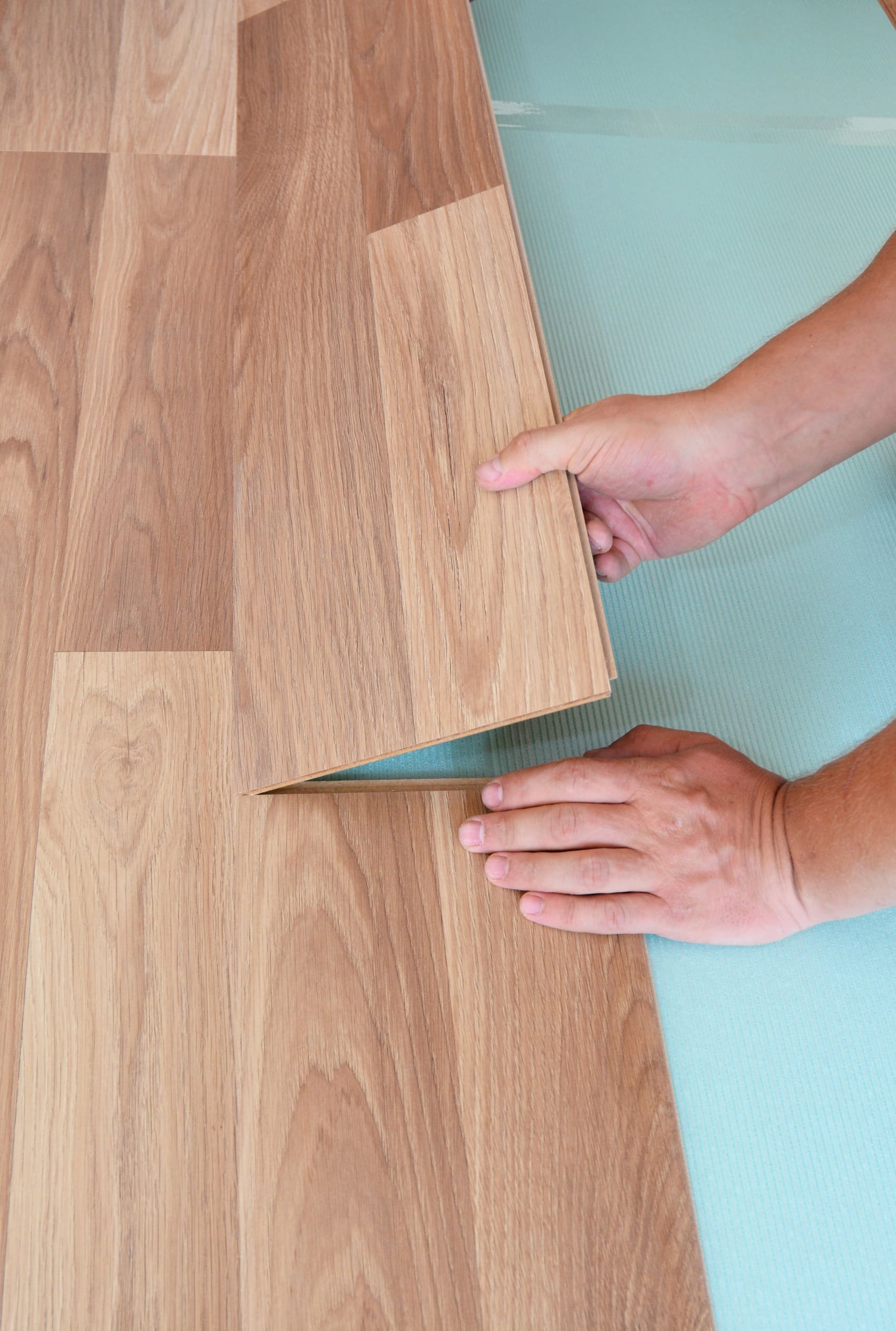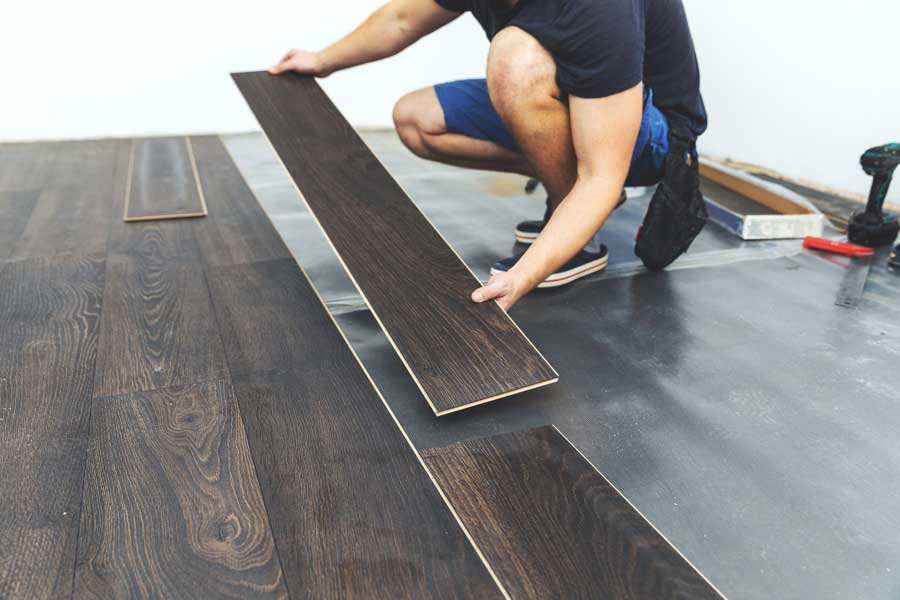
When choosing the best flooring type for your home, the possibilities may feel endless. One of the most popular flooring types on the market is waterproof laminate flooring because it comes in various wood-look styles, grain patterns, and colors. Best of all, you can install laminate flooring in rooms prone to high moisture and heavy foot traffic.
However, depending on your goals, laminate flooring may not be ideal for your home. This blog breaks down the pros and cons of laminate flooring and compares it to other sought-after wood-look residential flooring options on the market.
We cover:
Waterproof Laminate Flooring Composition
Laminate Flooring vs. Vinyl Flooring
- Composition
- Resistance
- Flooring Installation
- Flooring Maintenance
Laminate Flooring vs. Engineered Hardwood Flooring
- Flooring Composition
- Flooring Durability
- Water Resistance
- Flooring Installation
Comparison Chart: Laminate vs. Vinyl vs. Engineered Hardwood Flooring


What is Waterproof Laminate Flooring?
Firstly, waterproof laminate flooring is an upgraded version of laminate designed to resist water contact, not water damage. As with most flooring types, water pooling for an extended period can cause damage to the floor and subfloor beneath it.
Like other flooring types, regular laminate flooring can swell when it absorbs water. However, waterproof laminate features a water-repellent seal that keeps moisture from its core.
Additionally, some luxury laminate flooring features bevels that wrap over the plank’s edges to protect against water contact at the joints. Should water seep through both of those features, the waterproof laminate’s high-density fiberboard core layer will resist moisture better than regular laminate.


Laminate Flooring vs. Vinyl Flooring

Laminate vs. Vinyl Flooring Composition
Let’s start with the biggest difference —their material compositions. Most laminate flooring is made from resin and fiberboard materials. Vinyl flooring has several layers and features a polyvinyl chloride (PVC) base.
Laminate Flooring Layers
Backing Layer
Located at the very bottom, it is the foundation and protects the laminate and the subflooring.
Core Layer
The core layer offers additional protection through an ultra-durable fiberboard and resin composition that is water-resistant.
Pattern Layer
The pattern layer, sometimes called the image layer, gives the laminate its look and texture.
Wear Layer
This is the top layer of your laminate flooring. It is what stands up to color fading, scrapes, scratches, and more. The thicker the wear layer, the better the quality and durability.

Laminate vs. Vinyl Flooring Water Resistance
Your location plays a significant factor in determining the best type of flooring for your home. Expert Flooring Solutions is in Las Vegas, NV, where the climate is hot and dry with occasional humidity. For these reasons, solid hardwood flooring is not a wise choice, but engineered hardwood, laminate, and vinyl flooring are as they withstand different moisture levels.
If you are considering installing new floors in a kitchen or bathroom, which are susceptible to daily water spills, vinyl flooring is better as it is 100% waterproof. While waterproof laminate flooring is on the market, understand that “waterproof” may be used loosely in terms of protection. Most laminate can handle water spills that are quickly cleaned up but not standing water. If you decide to use laminate in your kitchen or bathroom, be sure to obtain testing guarantees and product warranties from the manufacturers that back up their water-resistant claims.
Laminate & Vinyl Flooring Installation
If the vinyl or laminate does not have a backer, an underlayment of foam sheeting will serve as a base.
Here at Expert Flooring Solutions, we provide installation services to customers who purchase any of our flooring options. However, if you plan to install laminate or vinyl flooring yourself, there are some key elements you need to know.
For starters, just because most planks click together and do not need to be nailed to the subfloor does not mean that all rooms or homes are fit for both laminate and vinyl flooring. Imperfections in your home’s subfloor can cause the planks to buckle over time.
If your subfloor has damage, it may need to be removed, and a rigid underlayment of thin plywood will need to be set down before laying the foam sheets and installing the flooring. We recommend consulting a flooring professional to ensure the installation will last and yield the results you are after.

Consult With a Flooring Expert and Get Free Flooring Samples to Take Home
Laminate Flooring vs. Vinyl Flooring Maintenance
Floor maintenance is one of the most important factors for homeowners shopping for new flooring. When it comes to ease of maintenance, laminate and vinyl provide easy cleanup without having to use multiple cleaning solutions.
To maintain the look of laminate and vinyl flooring, a daily sweep, dust mop, or vacuum is enough to prevent the accumulation of grit. Since laminate floors are not 100% waterproof, you should not use a wet mop to clean them; instead, use a damp cloth to spot clean messes.
For deep cleaning, use a cleaning product formulated for laminate or vinyl. Using other products such as detergent or soap can dull the look of the top layer.
Please avoid cleaning products that have an abrasive surface as they can damage your vinyl or laminate floors, and lastly, do not steam either option. Most laminate and vinyl flooring manufacturers include a list of approved cleaning methods and agents along with their products or via their website.
As you can see, both laminate and vinyl floors are easy to care for and similar in their care routines.

Laminate Flooring vs. Engineered Hardwood Flooring

Laminate vs. Engineered Hardwood Composition
Since we covered laminate flooring’s composition above, we will focus on the distinct characteristics of engineered hardwood flooring to those of laminate. Engineered hardwood comes in various colors, textures, grain patterns, and wood-look species like laminate.
The distinct difference between the two is the core and top layers. Laminate has a fiberboard core layer and features a printed image of wood as its top layer, while engineered hardwood has a plywood core layer and veneer top with natural hardwood, which gives it its distinct real-wood look.
Laminate vs. Engineered Hardwood Durability
If you have pets or small children who like to play in the house, engineered hardwood flooring may not be the best choice. While it resembles the look and feels of natural hardwood the best, it is not scratch and dent-resistant. Also, if your flooring will have direct exposure to sunlight, you may want to steer clear of engineered hardwood as it can potentially become discolored over time.
Laminate, on the other hand, will stand up to everyday scuffles a lot better, the tradeoff being lower qualities of laminate may have artificial-looking wood grain textures.


Laminate vs. Engineered Hardwood Flooring Water Resistance
The silver lining here is whichever you end up going with, both will be more water–resistant than traditional hardwood. However, laminate flooring’s man-made materials resist water much better than engineered hardwood’s real wood veneer top layer.

Laminate vs. Engineered Hardwood Flooring Installation
As shared above, laminate flooring can click and lock into place. Engineered hardwood flooring installation is more involved, with some engineered hardwood flooring requiring nailed or glue-down installation methods. The exception to this would be modern EHF options, which have a similar installation process to laminate via a click-lock installation method that does not require the need to be attached to the subfloor below.



